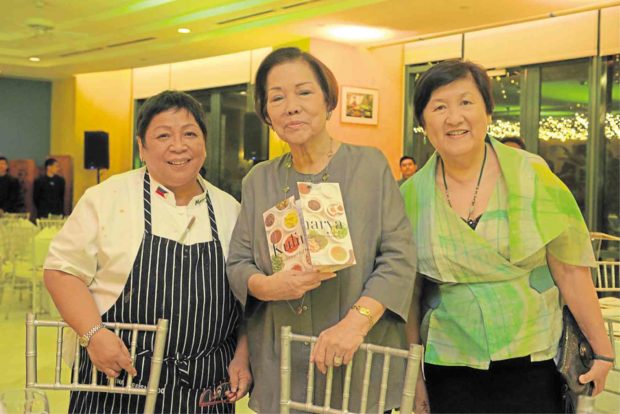
Batangas cooking was highlighted in the third Asia Society’s Kulinarya dinner series, with Myrna Segismundo’s menu. She was one of the chefs featured in the book “Kulinarya: A Guide to Philippine Food.” Her family hails from that Tagalog province.
For weeks while at work on the menu, Segismundo went to her native Lipa and checked out in the market what was in season. Tawilis was available.
Sardinella tawilis is the only one in the genus that exists in freshwater, in Taal lake, the province’s wonder not only because of the volcano, but also because of the prized tawilis and maliputo (giant trevally) found there.
Segismundo poached the small fish in vinegar (paksiw), then placed each piece on top of a biscocho, toasted old bread from a local panaderia (bakery).
‘Atcharang santol’
She also found atcharang santol. While the fruit is pickled whole in other places and in Chinese groceries, in Lipa, only the flesh is used and, with plenty of sugar—bees hover over their plastic tubs.
Segismundo said it is common knowledge in the area that the process was taught by a “Haponesa” (Japanese lady).
She also mentioned sinturis, Batangas’ name for the citrus commonly known as dalanghita, a name derived from the Spanish naranjita. Batangas used to be known as the source of the fruit because dalanghita orchards abounded there. The trees have been cut down because of disease or to make way for other produce.
These days, it is dalandan that supplies the citrus juice that was once provided by dalanghita. Having found some, Segismundo decided to make a sorbet with a bit of tuba (coco wine) as palate cleanser between courses.
Bulalo is expected when Batangas food is served. The broth is from boiled kneecap and shank bone but to get to the prized marrow, she sliced the bone lengthwise, and roasted it a bit in the oven. The marrow was spread on a biscocho while a corn and spring onion flan was served with the bulalo.
The other food in her menu were from dishes she whipped up through the years—as corporate director at Sign of the Anvil at PCIB Tower and at Restaurant 9501 at ABS-CBN’s ELJ building.
Grilled liver sauce
Segismundo served the boneless lechon with her grilled liver sauce, atchara and pako (fiddlehead fern) salad.
The lapu-lapu fillet and shrimps with crab fat cooked in coconut milk was a dish she served on a tour of four European cities in 2017. The vegetable dish with the seafood was bulanglang —boiled vegetables flavored with bagoong (fermented fish paste) from Balayan, Batangas.
She made her now famous adobo paté, again, a bit French but definitely adobo in flavor, that she served with kamias-pepper jelly together with chicken skewers flavored with tamarind.
Segismundo’s main course of kaldereta (stewed beef ribs) was definitely Batangas cooking, the recipe was her mother’s, a family heirloom. That was served with an upland heritage rice, the kandinga thankfully still grown and harvested in her province.
The dessert was a chocolate pili nut cake, the chocolate from Malagos in Davao. To connect it to her province, Segismundo laughingly pointed out how the cheesemaker and early proponent of the chocolate, Olive Puentespina, is from Batangas. The cake was crafted by her good friend and pastry chef, Jill Sandique.
Segismundo also served her version of banana turron. And the coffee had to be barako, the Liberica beans from, you guessed it, Batangas.
E-mail tha author at pinoyfood04@yahoo.com.